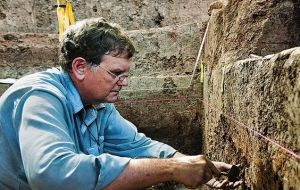MercoPress. South Atlantic News Agency
Humans came to the Americas earlier than thought, study shows
 An earlier occupation can not be ruled out, according to Michael R Waters, director of the Center for the Study of Early Americans at the Texas A&M University.
An earlier occupation can not be ruled out, according to Michael R Waters, director of the Center for the Study of Early Americans at the Texas A&M University. A study by a Texas university released Thursday sheds new light on the population of the Americas as it places humans in the continent 2,000 years before than science has been maintaining.
According to the publication, humans came from Asia to North America about 15,000 years ago and, after crossing the Isthmus of Panama, their migration bifurcated towards the Pacific coast and the Amazon in South America.
Although humans have traditionally been estimated to have arrived in America some 13,000 years ago, Michael R Waters, director of the Center for the Study of Early Americans at the Texas A&M University, concluded his review of the most recent research and indicated that evidence of an earlier occupation can not be ruled out.
North America and South America “were the last continents explored and colonized by modern humans at the end of the Pleistocene,” Waters wrote.
“The genetic information, obtained from contemporary populations and ancient individuals, shows that the first Americans came from Asia and, after several divisions of the population, marched south of the continental ice sheets that covered Canada,” he added.
This first migration occurred between 17,500 and 14,600 years ago, and the genetic data and archaeological evidence available up to now does not support the notion that there has been a human population in America before about 17,500 years ago.
Archaeological evidence proves that there were successful human populations in multiple sites in North America and South America from 15,500 to 14,000 years ago.
These populations used spearheads, arrows or cutting weapons with double edge, single-edged blades and instruments made of bones.
In addition to the knowledge obtained from the archaeological evidence, the most advanced genetic analyzes in recent years have allowed scientists to “trace a coherent but complex history of the first peoples that entered, explored and settled in the Americas,” Waters said.
These studies have shown that the ancestors of all contemporary indigenous peoples descended from only five maternal lineages and two parental lineages.
“The lineages also show that the foundational population came from Asia and experienced a serious genetic 'bottleneck', in which a small number of people with limited genetic diversity gave rise to all the indigenous peoples who occupied the continent before the arrival of Europeans,” wrote the researcher.
More studies of deoxyribonucleic acid “indicate that the original population from which the first Americans derived had been isolated from Asian lineages very likely in eastern Beringia before moving south.”
Beringia is the name given to an earth bridge that existed from the western end of Siberia to the west of Alaska, before the formation of the Bering Sea during the last glaciation and that served for humans to enter America.
After a stay in Beringia, “a small group split off from that isolated population, traveled south of the ice sheets that covered most of Canada and their descendants explored and populated the Americas,” he continued.
“We must always bear in mind that we investigate the ancestry of contemporary indigenous peoples and as such we should strive to include indigenous Americans in our studies as colleagues in our exploration of their past,” Waters said. “Collaboration between scientists and indigenous peoples will enrich our knowledge of the history of the first Americans,” he added.




Top Comments
Disclaimer & comment rules-

-

Read all comments< insert aggie jokes here >
Jul 12th, 2019 - 03:13 pm 0This article is an unfortunate example of how once a rumor gets started and is unchallenged, it's very hard to get it out of the heads of the many who swallowed it without chewing.
Jul 21st, 2019 - 10:21 am 0The ice bridge is clearly not the primary conveyance from Asia into the Americas. A statement was made “a small group” of people who had been walking on this ice bridge peeled off to bypass the glaciers and ice sheet, i.e. “Canada”, blocking them on the other side, without a reference it comprised a small group. The ocean was the highway from Asia to the Pacific NW coast! It's not like these people hadn't invented the boat yet! It's assumed titanic hordes of wild game strolled across, without grass, i.e., whatchacall “food” to nourish them, on their ridiculously long journey over glaciers and an ice-covered continent, is on its face a preposterous fantasy. The mythical megalopolis of game animals is given as a reason the humans supposedly followed them, when in fact a thriving oceanside community of fishermen in their large fishing skiffs used the ocean as their kitchen, even cooking their catch onboard. The idea they instead chose a laborious march on ice thousands of miles, far from the bounty of food on the much faster liquid superhighway/kitchen, is sheer idiocy.
The NW Indian tribes recount the ancient tales of their ancestors arriving below the ice sheet onto the actual land by boats, many boats, as it really happened, totally discounted as “myth” by the omniscient believers of the ice bridge religious cult. Just shows, once again, how science unquestioned and untested by simple logic dismisses and ignores the descendants of the Native travelers when they tried to explain it to the fool Anglos in the 19th century, forcing the question who are the true wise inhabitants living in actual reality and who are the dumb white know-it-all barbarian visitors clinging to their ridiculous fantasies and dumbing down another generation of fools led astray.
Drivel. It's bad for the mind.
Commenting for this story is now closed.
If you have a Facebook account, become a fan and comment on our Facebook Page!